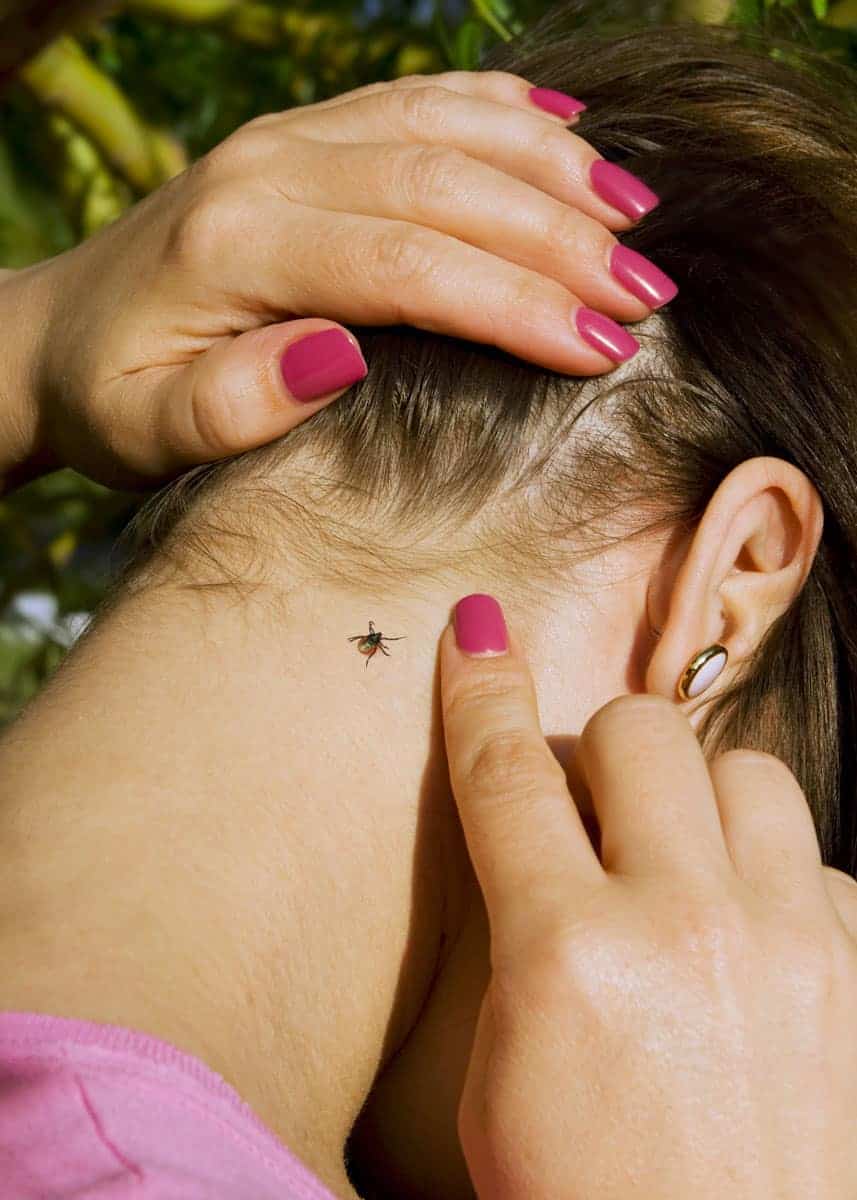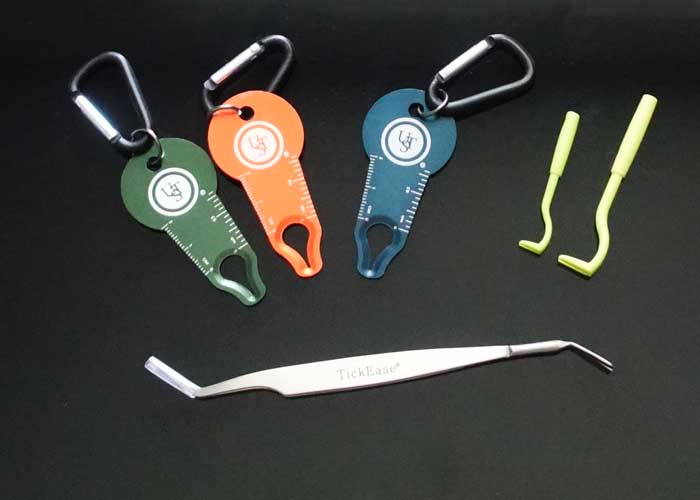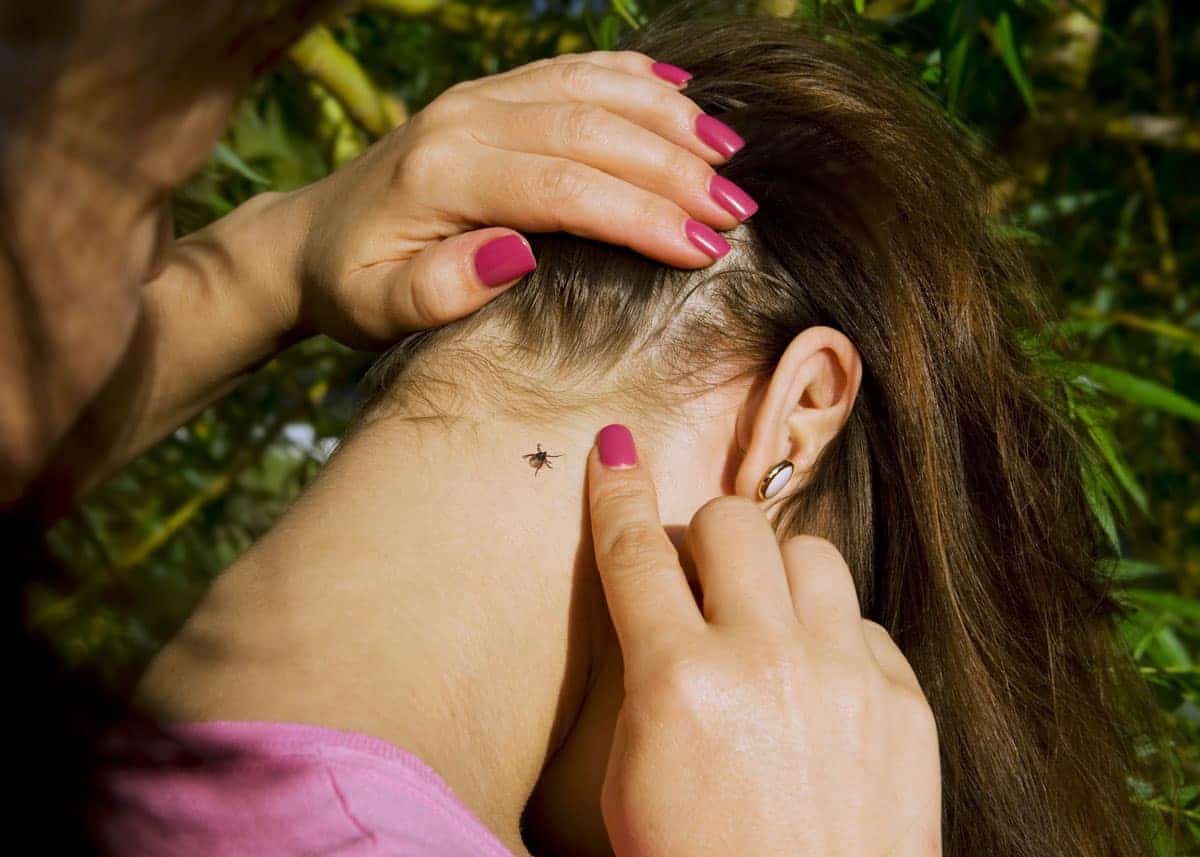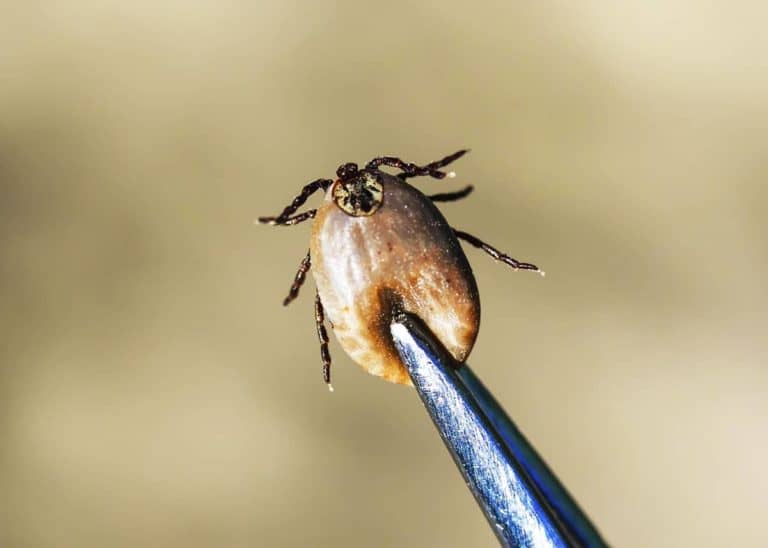5 Ways to Remove a Tick Head That Broke Off (Humans, Dogs, Cats)
So a tick bit you. And you quickly removed it – but it’s head broke off. Now what!!?? In this post, you’ll learn how to remove a tick head after the body is gone. I include tick removal methods for humans and dogs. Plus some things you should never do. And we’ll answer some common questions about tick removal and safety.

How to Remove a Tick Head (Humans, Dogs, Cats)
The sun is shining. Your dog is frolicking through the grass. Everything is perfect… until you notice that little black spot on his fur.
It isn’t difficult to remove a tick. The tricky part is making sure that the head and body are gone, especially if parts of the bug have broken off during the extraction process. While a dead tick can’t spread disease like a live one, its presence in your body can still lead to infections, irritations, and inflammations.
Long story short, you’ll want to get that tick off you. The head is just as bad as the rest of the body. Consider this your guide on how to remove a tick head and stay safe.
This post is divided into two primary sections: removing tick heads from humans and pets. Plus, you’ll learn 6 things not to do, and we’ll answer ten common questions.
Want to kill the tick? Here are 13 ways to kill a tick.
5 Step by Step Guides: Remove a Tick Head From Humans
If you’ve plucked a tick from your arm but you still notice a dark spot in the middle of a red, irritated bite, the head has probably broken off and is still attached to your skin.
Here are just a few ways that you might remove it.
1. Credit Card
This is one of the quickest and easiest ways to remove a tick head. All it takes is a hard-edged card. A plastic credit card is ideal, but you could also use a playing card or business card made with thick stock.
To remove all traces of the tick:
- Locate the head.
- Press the credit card to the surrounding skin. Do not press directly into the head; that will just force it deeper.
- Apply a slow and steady pressure with the credit card until the tick head pops up and out of the skin.
The most important thing about this removal method is that you don’t overdo it. You aren’t trying to build up an explosive force that will make the tick head shoot out of your skin like a water jet.
Just apply a slow and steady pressure that draws it to the surface.
2. Tweezers
This is a tick removal method that you probably already know. It’s pretty straightforward:
- Find the tick head.
- Use the tweezers to gently grasp it on both sides.
- Pull it out.
Tick heads don’t expel their contents under pressure, so you don’t have to worry about the usual “regurgitating tick” thing.
This is a concern when removing an attached tick – you risk squeezing the contents of the tick back into your body. Gross, I know. But it brings the risk of receiving the bacteria
Here’s a specialty pair of tweezers made for tick removal.
The only bad thing about using tweezers to remove a tick head is that it doesn’t always work. The head might be deeply buried in the skin; the entry point might not be big enough to draw it out. If you’re removing the body at the same time, there might be mouthparts that break off with the pressure of your squeeze.
Don’t force the tweezer method if it isn’t working. Try something else until you find the right solution for your particular tick.
3. Needle
What if the tick head is completely embedded under the skin? What if you can’t reach it with tweezers or other tools? You might need to bring it to the surface with the help of a needle.
It should go without saying that you’ll need to be very careful with this method. Puncturing your skin with any kind of object can increase the risk of infections and irritations, and there’s no guarantee that you’ll be able to reach the tick head with your needle. You might even push it deeper into your skin!
If you’re eager to get it out, however, and you’re sure that you have the fine motor skills to wield a needle, here’s what you do:
- Sterilize the needle by boiling it or rubbing it with alcohol.
- Locate the entry point of the tick bite.
- Use the needle to gently prick the skin and create or widen an opening for the tick head to pass through.
- If the tick head is intact, you might be able to spear it on the point of your needle and fish it out. Otherwise, grab your tweezers and use them to pull out what your needle has exposed.
4. Razor Blade
This is another tick removal method that will require the utmost care. You won’t want to use it on kids, pets or other squirmers.
Only use it on yourself or other adults, and only use it under a specific circumstance: when you can see the tick head poking through the skin.
- Sterilize the blade.
- Hold your skin between two fingers. Try not to pinch or squeeze; you don’t want to build up that explosive pressure that we were talking about earlier. Just gather it between your fingers.
- Locate the tick head. It should already be poking through the skin.
- Using the edge of the blade, scrape off the tick head. Go sideways. Try to do it on your first attempt without needing a repeat.
As you can see, the goal is not to cut your skin with a razor blade. You’re just using it as a sterile instrument to scrape the tick head away.
You can use other scraping tools as well, but a razor blade is something that you probably already have at home, so it’s ideal for an unexpected tick.
5. Epsom Salt
Contrary to what you might have read on the web, Epsom salt doesn’t “dissolve” a tick head. You wouldn’t want that to happen under your skin, anyway!
The benefit of Epsom salt for tick bites is that it reduces pain and inflammation. It can help you soothe down the red, swollen skin of your tick bite and expose any head or body parts that might be trapped in it.
Here’s how to use Epsom salt to draw out a tick head:
- Dissolve the salt in warm water.
- Soak a rag or cloth in the mixture.
- Apply your compress directly to your tick bite for 10 – 15 minutes.
You might have to do this a few times throughout the day before you start seeing results. When it works, however, Epsom salt is a great all-natural method for removing tick heads.
Want to avoid getting a tick in the first place? Here are 7 tips for avoiding ticks while hiking.
You never know when you might get a tick. It could be a long hike to that secluded waterfall or even a short nature walk in town.
How to Remove a Tick Head From Pets
Some of these methods are the same as removing a tick from a human, but you might need to take extra precautions since you’re dealing with a wiggly fur baby.
When in doubt, take your time. It’s better to be annoyingly thorough than to rush through it and leave part of a tick on your precious pooch.
1. Tweezers
The biggest challenge of using tweezers on your pet is getting through their fur to actually reach the tick. You might need to rope in a friend or relative to hold the fur apart while you work on the tick head.
Otherwise, the removal process is the same: Grasp it firmly and pull upwards with slow, steady pressure.
Check out these tick tweezers on Amazon.
2. Tick Removal Pliers
Tick removal pliers work a lot like tweezers, but they come with special features for the extraction and identification of ticks.
For example, they might have a built-in magnification lens so that you don’t leave any part of the tick behind, or they might have a little holding chamber for the tick if you want to get it tested. But for simple removal, this tick twister should do the trick.
Tick removal pliers can be used with both pets and humans, but they’re especially nice for pets since they work on all kinds of hair, fur, and skin. If your cat or dog has a persistent tick problem, tick removal pliers might be a good investment for the future.
3. Vet Visit
If Fluffy just isn’t cooperating with your attempts at tick removal, you might need professional assistance.
Vets have the tools and training to deal with even the most stubborn of patients, so they should be able to get rid of all traces of the tick. They’ll also have the resources to test the tick for diseases after they remove it.
More reading: Here’s how to boil water for drinking on your hike
6 Things to Avoid When Removing Tick Heads
Now that you know how to safely remove a tick head, let’s talk about some of the things that you shouldn’t do when ridding yourself of these pesky creatures.
- Don’t use square-tipped tweezers. Use fine-tipped ones. They’ll give you more control and precision over the removal process, and you’ll reduce the risk of squeezing too hard and making a mess.
- Don’t wiggle the tick head from side to side. If you have an aggravating tick head that doesn’t want to come out, resist the urge to shake or push it around with your tools. Try a different removal method instead of forcing an unsuccessful one.
- Don’t use chemical products to remove a tick head. Your grandma might swear by nail polish or petroleum jelly, but there’s no evidence to suggest that these things actually work. The only product that might help with a tick bite is Epsom salt, and it just soothes the surrounding skin rather than having any impact on the head itself.
- Don’t try to “burn the tick off.” Live ticks will respond to the heat by producing more saliva and increasing your risk of disease. Dead ticks won’t care about your lighter, but you won’t actually accomplish anything by burning them. You’ll just burn your skin.
- Don’t dig around your skin with needles, razors or tweezers. You might make things worse by inflaming the wound or getting more bacteria in it.
- Don’t panic. Dead ticks are much less dangerous than live ones. If you’ve already killed the tick, you’ve killed most of the risk. Removing the leftover body parts is just a precautionary measure against infections, so don’t stress out.
10 Common Questions About Ticks
Before you grab the tweezers and get started, you might want to clear up some lingering questions about tick removal.
Here’s an FAQ for removing tick heads from kids, cats, dogs and anyone else who can’t resist the lure of tall grass.
1. Is it dangerous to leave a tick head under your skin?
It isn’t ideal. Dead ticks can’t transmit blood or saliva, so a disembodied tick head isn’t likely to give you any diseases, but there’s still a risk of infection.
Letting a tick head stay under your skin can also cause all kinds of painful irritations and inflammations. All things considered, you should try to remove every part of the tick from your body after you’ve been bitten.
2. Will tick heads go away on their own?
It depends. Some tick heads can naturally expel themselves after everyday wear and tear; others can get stuck under the skin and cause infections. Our advice is to always remove a tick head when you see it. Don’t play the odds.
3. How do I remove a tick that is completely under the skin?
Good news! Ticks don’t really “burrow” under your skin. They only stick their heads inside so that their mouthparts can feed.
Even if you have a stubborn tick that’s really clinging to your arm or leg, there should be something for you to grab with tweezers or other tools, and removing it correctly should leave no part behind.
4. What if a tick head is completely under my skin?
It’s possible for tick heads to embed themselves under the skin in ways that tick bodies can’t.
They’re much smaller, and they’re already beneath the surface when you yank their bodies out. It’s easy for heads to break away and get trapped.
Removing a tick head can be done in several ways:
- You can snag them with tweezers or special tick removal pliers.
- You can apply pressure to the surrounding skin with a hard-edged credit card, forcing them to rise to the surface.
- If they’re already poking out, you can hold the skin between two fingers and scrape them off with the side of a razor blade.
5. How can I tell if there’s a tick head under my skin?
The most obvious sign is a dark spot in the middle of your tick bite. It might be black, brown or grey depending on the tick species, but it should stand out in comparison to red skin or white pus.
You can also use your finger to gently poke at the tick bite and see if you feel a lump under your skin. It might not be a big one; tick heads can be minuscule compared to their bloated bodies after feeding.
You’ll also want to take care that you aren’t confusing regular swelling with swelling from an embedded tick head.
6. Can I remove tick heads with Epsom salt?
It’s worth a try. Epsom salt is an anti-inflammatory, so it can reduce the swelling around a tick bite. It might soothe your skin enough to push out the tick head. If the head is deeply embedded, Epsom salt can make it more visible or accessible for extraction.
There are two ways to use Epsom salt for ticks:
- Mix the salt with warm water and soak a compress in it. Apply the compress to your tick bite for 10 – 15 minutes at a time.
- Take an Epsom salt bath. If the bite is on your hand or foot, you can use a bucket bath meant for nail care. This will completely submerge your wound without irritating your skin with a cloth.
7. Is there a difference in tick removal for cats and dogs?
No. You can use the same tick removal methods on any kind of animal.
As a matter of fact, you can use the same methods on any human or animal. It’s just that some tools or procedures might be better suited for stoic adults than scared kids or pets.
8. How do I remove a tick head without tweezers?
Tweezers aren’t the only way to remove a tick head. You have several options:
- A hard-edged credit card can be pressed to the skin to force the head up and out.
- If a tick head is deeply embedded in your skin, a needle might be better than tweezers. You can use it to prick the entry point of the wound and push the head out.
- Epsom salts mixed with warm water can reduce the inflammation of a tick bite and encourage the head to come out.
9. How do I remove a tick with Vaseline?
Don’t use Vaseline for tick removal! The same goes for oil, fire, kerosene, nail polish and petroleum jelly.
These things won’t actually “drown” or “burn” the tick, and they won’t do anything about its embedded head or mouthparts. They’ll only make the situation worse.
10. When should I be worried about an embedded tick head?
Tick heads should fall out within 36 hours of a bite. If it’s been 36 hours and the head is still lodged beneath your skin, you’ll want to call your doctor.
There’s no need to panic, but there’s no need to increase your risk of infection by waiting around for a stubborn tick head to expel itself, either.
Your Turn
These are just a few things to keep in mind if you’re wondering how to remove a tick head. You don’t have to let the bloodsuckers ruin your summer!
Just stay alert and aware about the possibility of tick bites, and if you find yourself in a situation where the head is proving more difficult to extract than the body, use these tips to get rid of it for good.
Have a tip or story to share? Join me below!













My site really hurts. It feels deep, the pain. I honestly don’t know how long it’s been there. It wasn’t swollen or alive. Or was it, and all the bad tick juice came out into my clavicle area?
I got it out, but it is very painful.
Not my first tick bite, but the first one that hurts so bad.
I used a sterile syringe to remove a minuscule tick head. After using a sterile hypodermic needle to make a small cut to enlarge the site of entry, I placed the syringe tip directly on the site and pull back. I did this three times to make sure the head parts were all out. It worked like a charm.